 |
|
The Rundown on The Main Injector A Quick Jog: The Main Injector is about two miles in circumference (as is its tunnel-mate, the Recycler). Particles will travel around the Main Injector and Recycler nearly 100,000 times per second. State-of-the-art funding: A $2.2 million Challenge Grant from the State of Illinois in 1991 gave Fermilab enough funding to take the first step in building the new Main Injector: the completion of the required environmental impact studies. With that vote of confidence from the State of Illinois, Fermilab was able to go on to build the eight-year, $259 million project that will soon be creating the best opportunities anywhere on earth for physics at the energy frontier.
Great Acceleration: The Main Injector can accelerate 30 trillion protons to an energy of 150 GeV (billion electron volts). It will allow Fermilab to produce 200 billion antiprotons every hour. Anchors Aweigh: Building the new magnets for the Main Injector required 8,300 tons of steel, equivalent to the weight of a U.S. Navy destroyer in World War II.
Sound Construction: The Recycler permanent magnets use a total of 45,000 strontium-ferrite "bricks" (each measuring 4" x 6" x 1") to produce their magnetic fields. Each brick is similar in composition and weight to the material used in a stereo speaker. Utilities Included: The permanent magnets in the Recycler operate without the need for power and water. Department of Energy: The average home carries an electrical current of 20 amperes. Both Type 1 and Type 2 Main Injector magnets carry a peak current of 9,375 amperes, almost 500 times that of the average home. Not for Refrigerators: The Main Injector uses three types of quadrupole electromagnets to focus the particle beam, or keep it narrow. There are 48 Type I magnets (8 feet long, weighing 11,100 pounds each); 32 Type 2 magnets (10 feet long, weighing 12,900 pounds each), and 128 Type 3 magnets (7 feet long, weighing 9,400 pounds each). Power Saver Mode: The Main Injector quadrupole magnets carry a peak current of 3,630 amperes. How Many Pennies is That? Making the coils for the Main Injector electromagnets took 888 tons of copper. What a Line: Power distribution to the Main Injector service buildings and to the adjacent area of the Tevatron required installing 182,000 line-feet of triplexed cable in new underground duct banks.
But No Condos: New service buildings added more than 58,700 square feet of building area. Traffic Pattern: Adding and changing access routes added 2.5 miles of paved roadway to the site system. Staking A Claim: The Main Injector project affected more than 500 acres of the Fermilab site.
Itís Always Saturday Night: The Main Injector uses de-ionized Low Conductivity Water (LCW) to cool electrical components, including magnets. LCW passes through each magnet at a rate of 12 gallons per minute (GPM), or about the equivalent of the water flow in a bathtub. Go With The Flow: Cooling all the Main Injector componentsómagnets, copper bus, power suppliesórequires 8,000 GPM regulated to 95 degrees (Fahrenheit). The Main Injector needs an estimated 50,000 gallons of LCW to fill all the pipes, storage tanks, bus tubes and magnets. A total of 4.5 miles of six-inch stainless steel pipe was installed in the Main Injector enclosure. Pumped Up: Each of the six service buildings in the Main Injector ring has three pumps, for a total of 18. Each pump has a 100 horsepower motor and delivers 550 GPM with a pressure head of 164 pounds per square inch (PSI).
|
| last modified 6/1/1999 email Fermilab |
FRLsDFx9eyfrPXgV
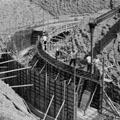 Pulling
Together: Building the Main Injector required 900 person-years of Fermilab effort
and six years of construction, with the use of 35 major outside contractors. Total
cost: $259,000,000. The project was completed on time and on budget.
Pulling
Together: Building the Main Injector required 900 person-years of Fermilab effort
and six years of construction, with the use of 35 major outside contractors. Total
cost: $259,000,000. The project was completed on time and on budget.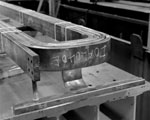 The
Main Attraction: The Main Injector uses two types of dipole electromagnets to
steer the particle beam. There are 216 Type I magnets (14 feet long, weighing 26,400
pounds each) and 208 Type 2 magnets (20 feet long, weighing 37,400 pounds each).
The
Main Attraction: The Main Injector uses two types of dipole electromagnets to
steer the particle beam. There are 216 Type I magnets (14 feet long, weighing 26,400
pounds each) and 208 Type 2 magnets (20 feet long, weighing 37,400 pounds each).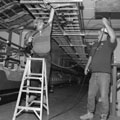 Cable
Guy: A network of more than 8,000 cables, carrying signals for more than 44,000
system parameters, was installed to operate the Main Injector. If the cables were
laid end to end, they would stretch about three million feetólong enough to traverse
the 550 miles between Fermilab and Memphis, Tennessee.
Cable
Guy: A network of more than 8,000 cables, carrying signals for more than 44,000
system parameters, was installed to operate the Main Injector. If the cables were
laid end to end, they would stretch about three million feetólong enough to traverse
the 550 miles between Fermilab and Memphis, Tennessee.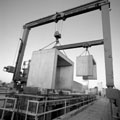 Concrete
Examples: The Main Injector civil construction project required more than 1,460,000
cubic yards (CY) of excavation, and 50,300 CY of cast-in-place concrete. An additional
1,392 precast concrete elements (each weighing approximately 18 tons) were used,
requiring 11,935 CY of concrete.
Concrete
Examples: The Main Injector civil construction project required more than 1,460,000
cubic yards (CY) of excavation, and 50,300 CY of cast-in-place concrete. An additional
1,392 precast concrete elements (each weighing approximately 18 tons) were used,
requiring 11,935 CY of concrete.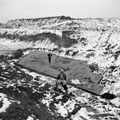 Heavy
Metal: More than 10,400 tons of 9-inch-thick continuous-cast steel plate was
installed as shielding over the beam enclosures.
Heavy
Metal: More than 10,400 tons of 9-inch-thick continuous-cast steel plate was
installed as shielding over the beam enclosures. Waterfront
Acreage: The six new cooling ponds have a surface area of more than 20 acres,
and hold some 32.5 million gallons of water.
Waterfront
Acreage: The six new cooling ponds have a surface area of more than 20 acres,
and hold some 32.5 million gallons of water.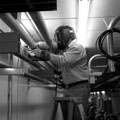 Allís Weld That Ends Weld: Repairing the 200 leaks discovered in the LCW system in November 1997 meant repairing nearly 4,000 welds in the stainless steel pipe, eradicating several strains of stubborn bacteria, and inventing miniature machines to scour out the inside of the pipe, at a cost of about $1,000,000.
Allís Weld That Ends Weld: Repairing the 200 leaks discovered in the LCW system in November 1997 meant repairing nearly 4,000 welds in the stainless steel pipe, eradicating several strains of stubborn bacteria, and inventing miniature machines to scour out the inside of the pipe, at a cost of about $1,000,000.